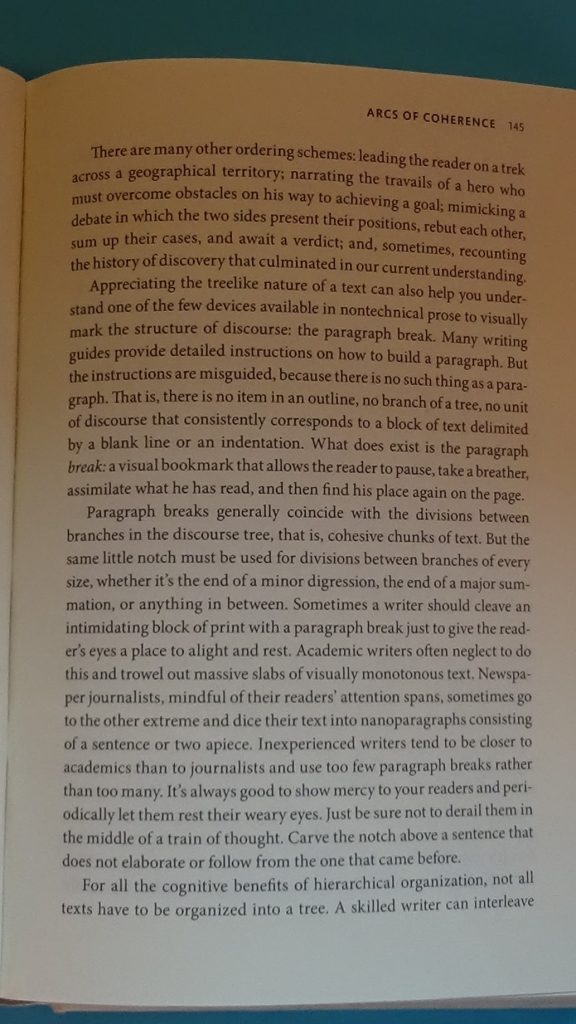I continued to use the form of the prose poem which for me has come to fit Pound’s postulate of “a center around which, not a box within which.” (Rosmarie Waldrop)
Steven Pinker and Iain McGee seem to think of the paragraph as a kind of punctuation mark. “Sometimes a writer should cleave an intimidating block of print with a paragraph break just to give the reader’s eyes a place to alight and rest,” says Pinker (p. 145). “Academic writers often neglect to do this and trowel out massive slabs of visually monotonous text.” I’m struck here by the words “just” and “visually”; it seems to me that a writer should never use a paragraph break just to rest, nor think that the monotony of a slab of prose is merely visual. McGee also thinks of the paragraph is as point of rest, but now for the writer. “Writers often pause before starting a new paragraph,” he explains; “indeed, the paragraph is a key … extended pause position in most writing” (p. 239). Both seem to think of prose as a sort of continuous flow that needs to be modulated somehow, given rhythm or a beat, made to oscillate between activity and rest, lest it just go on and on and on. Paragraphs, they seem to think, must be imposed on discourse, not, as I want to argue, composed into them.
Taken together, Pinker and McGee make us think of the paragraph according to its entirely practical, essentially physical, aspect. This approach has much to recommend it. After all, a paragraph is, first and foremost, something we make with our hands to be viewed with the eyes. But this, I want to argue, should not obscure the intellectual structure of paragraphs. A writer’s problem is not merely to put words on a page in a visually pleasing manner; it is to express an idea. Prose is supposed to facilitate the communion of minds, i.e., communication between knowledgeable people. Here, I think, the paragraph plays more than an incidental role.
But to begin with the physical facts: a paragraph ideally consists of at least six sentences and at most 200 words and can be read in about one minute. In that minute, a discrete idea (usually one that can be summarized in a single declarative sentence) is delivered into the mind of the reader along with the writer’s reasons to think it. Those reasons may support the idea in the reader’s mind or open the idea to the reader’s criticism, but the basic structure remains the same. The paragraph says one thing and supports, elaborates or defends it. Paragraphs can be distinguished by their propositional content (the things they say) and their rhetorical posture (they way they say them). The break between paragraphs, then, is either a change of content or a shift of posture (or both). The practiced reader gets used to this and the experience, therefore, is more interesting than merely taking a rest.
It gets even more interesting from the point of view of the writer. Here, again ideally, the paragraph is composed during a single, well-defined “writing moment” lasting 27 minutes. During that time the writer is engaged deliberately in supporting, elaborating, or supporting a single claim that has been decided upon the day before. McGee is certainly right that, working in this way, the writer will experience the paragraph break as a key moment of rest. Indeed, I would recommend taking a three-minute break and then moving on to the next paragraph.
These conditions are admittedly “idealized”. Most writers will balk at working in such an orderly way. I recommend it for anyone who experiences writing as a difficulty they want to become better at overcoming. Approaching your writing one moment at a time during an eight-week period, devoting, say, 80 hours to the composition of 160 paragraphs will teach you something about your style and build your strength as a writer (just as certainly as devoting 20 hours over those same eight weeks to running 120 kilometers will get you into better shape.) Afterwards, you may choose to write in a less disciplined manner, but your sense of the of paragraph will have changed because you have been paying attention to what happens between the breaks, to the internal structure of the paragraph, not its external limitations. Indeed, as I’ve argued before, you may come to appreciate the texture of time in your prose, not merely the structure of its space.
Ezra Pound taught Rosemarie Waldrop to think of form not as a “box within which” but as a “center around which”. I fear Pinker and McGee are teaching the opposite lesson. They are encouraging us to “break” up our stream of consciousness according to intellectually arbitrary principles. While my 27 minutes are certainly “intellectually arbitrary”, I am encouraging writers to establish these moments precisely to let them compose their thoughts, to generously spend significantly more time doing this than the reader (who spends only one minute) trying to understand them. Pinker says that “detailed instructions on how to build a paragraph … are misguided”; but I want to counter that paragraphs are precisely best understood as something we build. A paragraph is constructed during an extended moment to present a thought to the reader. It not is not merely a break during which our thoughts are momentarily interrupted by a visual “bookmark”. The paragraph truly is the unit of prose style. It is not just a piece of punctuation.
